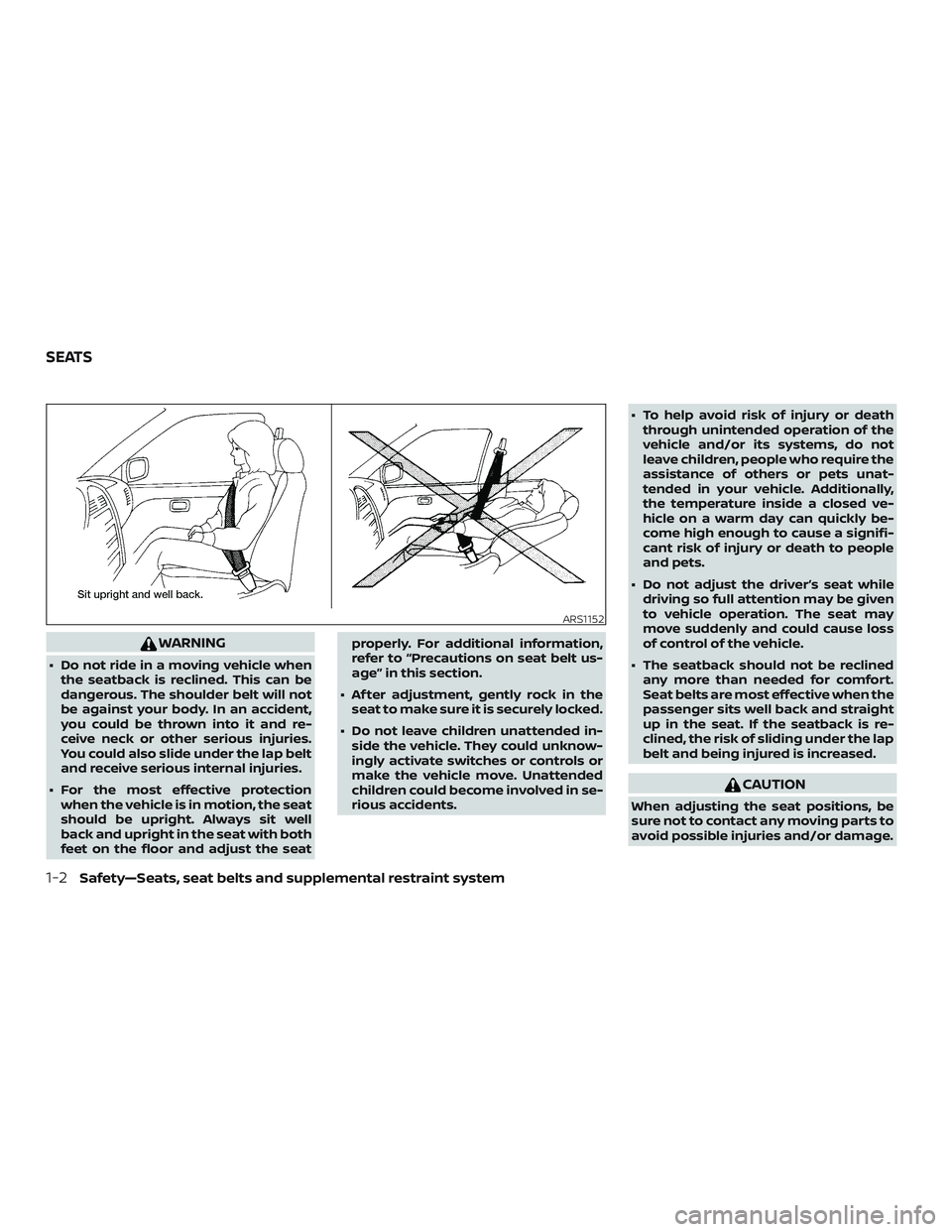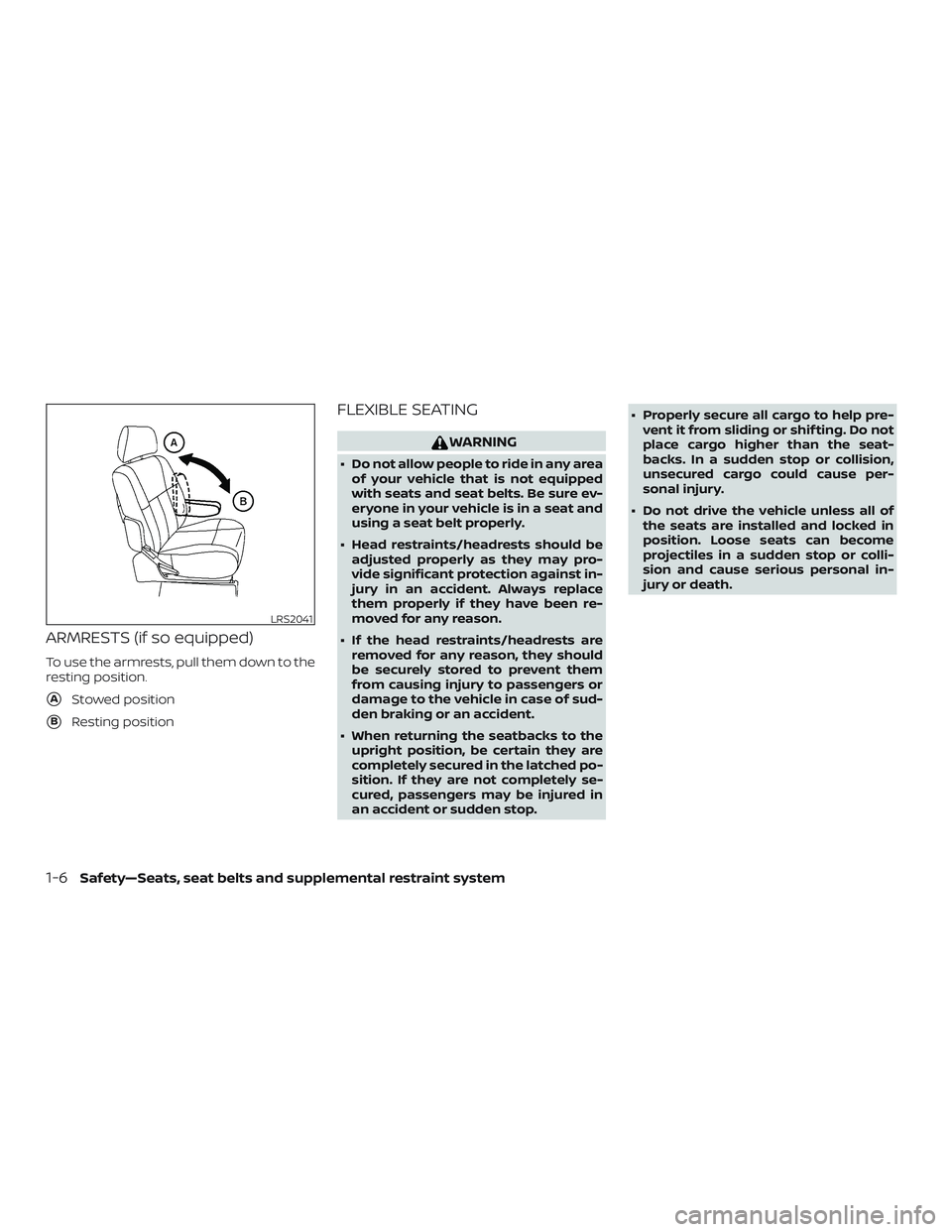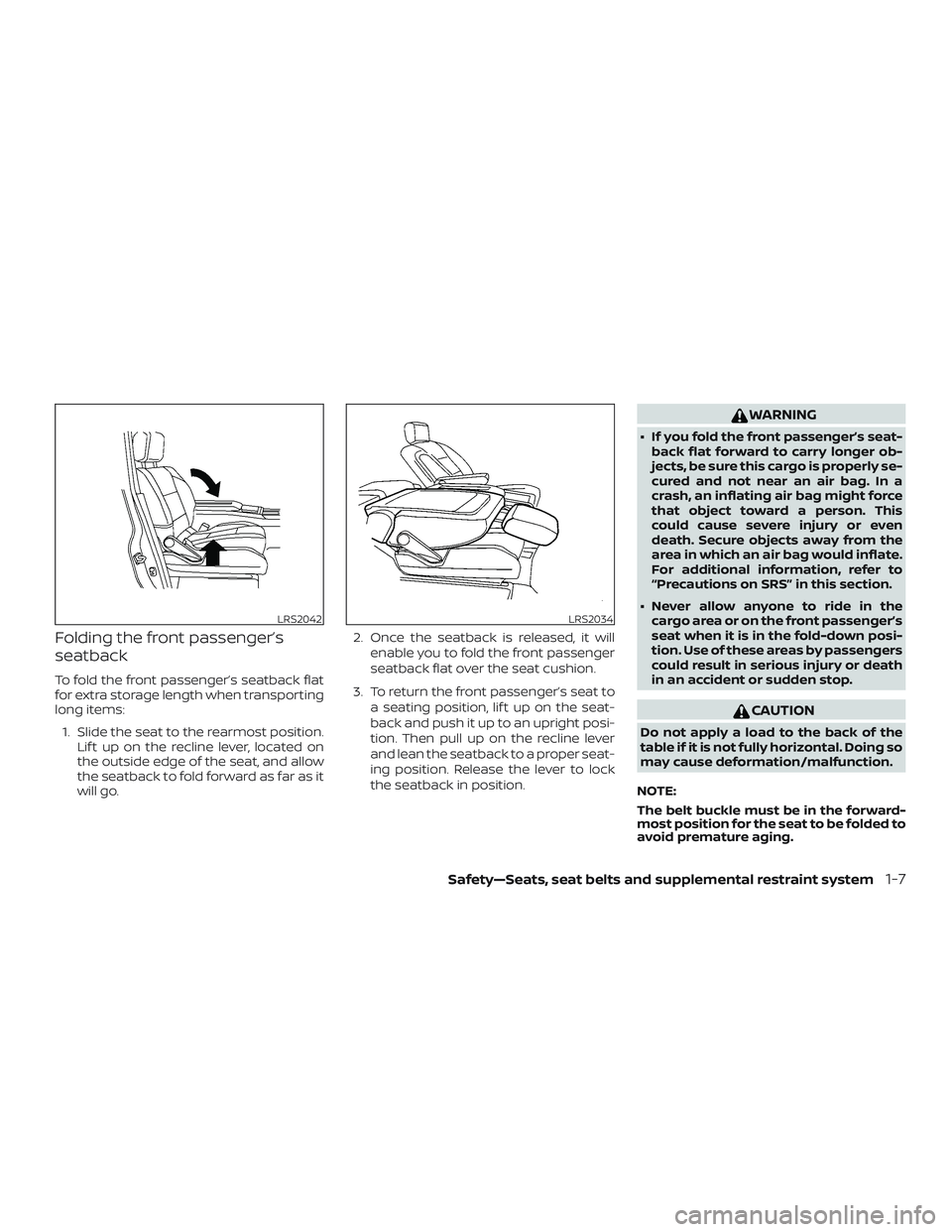Page 20 of 426
Indicatorlight Name Page
Malfunction
Indicator Light
(MIL) 2-24
Security indicator
light (if so
equipped) 2-25
Slip indicator light 2-25
TOW mode ON
indicator light
(if so equipped)2-25
Turn signal/
hazard indicator
lights2-25
Vehicle Dynamic
Control (VDC) OFF
indicator light2-25
Illustrated table of contents0-11
Page 23 of 426

WARNING
∙ Do not ride in a moving vehicle whenthe seatback is reclined. This can be
dangerous. The shoulder belt will not
be against your body. In an accident,
you could be thrown into it and re-
ceive neck or other serious injuries.
You could also slide under the lap belt
and receive serious internal injuries.
∙ For the most effective protection when the vehicle is in motion, the seat
should be upright. Always sit well
back and upright in the seat with both
feet on the floor and adjust the seat properly. For additional information,
refer to “Precautions on seat belt us-
age” in this section.
∙ Af ter adjustment, gently rock in the seat to make sure it is securely locked.
∙ Do not leave children unattended in- side the vehicle. They could unknow-
ingly activate switches or controls or
make the vehicle move. Unattended
children could become involved in se-
rious accidents. ∙ To help avoid risk of injury or death
through unintended operation of the
vehicle and/or its systems, do not
leave children, people who require the
assistance of others or pets unat-
tended in your vehicle. Additionally,
the temperature inside a closed ve-
hicle on a warm day can quickly be-
come high enough to cause a signifi-
cant risk of injury or death to people
and pets.
∙ Do not adjust the driver’s seat while driving so full attention may be given
to vehicle operation. The seat may
move suddenly and could cause loss
of control of the vehicle.
∙ The seatback should not be reclined any more than needed for comfort.
Seat belts are most effective when the
passenger sits well back and straight
up in the seat. If the seatback is re-
clined, the risk of sliding under the lap
belt and being injured is increased.
CAUTION
When adjusting the seat positions, be
sure not to contact any moving parts to
avoid possible injuries and/or damage.
ARS1152
SEATS
1-2Safety—Seats, seat belts and supplemental restraint system
Page 27 of 426

ARMRESTS (if so equipped)
To use the armrests, pull them down to the
resting position.
�AStowed position
�BResting position
FLEXIBLE SEATING
WARNING
∙ Do not allow people to ride in any areaof your vehicle that is not equipped
with seats and seat belts. Be sure ev-
eryone in your vehicle is in a seat and
using a seat belt properly.
∙ Head restraints/headrests should be adjusted properly as they may pro-
vide significant protection against in-
jury in an accident. Always replace
them properly if they have been re-
moved for any reason.
∙ If the head restraints/headrests are removed for any reason, they should
be securely stored to prevent them
from causing injury to passengers or
damage to the vehicle in case of sud-
den braking or an accident.
∙ When returning the seatbacks to the upright position, be certain they are
completely secured in the latched po-
sition. If they are not completely se-
cured, passengers may be injured in
an accident or sudden stop. ∙ Properly secure all cargo to help pre-
vent it from sliding or shif ting. Do not
place cargo higher than the seat-
backs. In a sudden stop or collision,
unsecured cargo could cause per-
sonal injury.
∙ Do not drive the vehicle unless all of the seats are installed and locked in
position. Loose seats can become
projectiles in a sudden stop or colli-
sion and cause serious personal in-
jury or death.
LRS2041
1-6Safety—Seats, seat belts and supplemental restraint system
Page 28 of 426

Folding the front passenger’s
seatback
To fold the front passenger’s seatback flat
for extra storage length when transporting
long items:1. Slide the seat to the rearmost position. Lif t up on the recline lever, located on
the outside edge of the seat, and allow
the seatback to fold forward as far as it
will go. 2. Once the seatback is released, it will
enable you to fold the front passenger
seatback flat over the seat cushion.
3. To return the front passenger’s seat to a seating position, lif t up on the seat-
back and push it up to an upright posi-
tion. Then pull up on the recline lever
and lean the seatback to a proper seat-
ing position. Release the lever to lock
the seatback in position.
WARNING
∙ If you fold the front passenger’s seat-back flat forward to carry longer ob-
jects, be sure this cargo is properly se-
cured and not near an air bag. In a
crash, an inflating air bag might force
that object toward a person. This
could cause severe injury or even
death. Secure objects away from the
area in which an air bag would inflate.
For additional information, refer to
“Precautions on SRS” in this section.
∙ Never allow anyone to ride in the cargo area or on the front passenger’s
seat when it is in the fold-down posi-
tion. Use of these areas by passengers
could result in serious injury or death
in an accident or sudden stop.
CAUTION
Do not apply a load to the back of the
table if it is not fully horizontal. Doing so
may cause deformation/malfunction.
NOTE:
The belt buckle must be in the forward-
most position for the seat to be folded to
avoid premature aging.
LRS2042LRS2034
Safety—Seats, seat belts and supplemental restraint system1-7
Page 30 of 426
2. Stand directly behind the seat and pullup and rearward on the straps to dis-
engage the seat. 3. Push up and forward to remove the
seats from the wells. 4. Rest the seat on the vehicle floor and
with two people, remove the seat from
the vehicle. Store the seat in a safe lo-
cation.
NOTE:
The 4th row seat has rollers on the seat
frame to make the seat easier to move to
a secure location.
LRS2104LRS2647LRS2109
Safety—Seats, seat belts and supplemental restraint system1-9
Page 33 of 426

SEAT RAIL COVERS
Your vehicle has eight factory installed
small rail covers. It also comes with a Large
Seat Rail Cover kit. The kit contains four
large rail covers that can be used to cover
the seat tracks when the single seats in the
2nd and/or 3rd rows have been removed. If
additional seats are removed and you wish
to cover the seat tracks, contact the Parts
Department at a NISSAN dealer for the lat-
est parts information.Both the small and large seat rail covers
can be removed and installed the same
way.
WARNING
Properly stow the rail covers when not
in use. They should be securely stored
to prevent them from causing injury to
passengers or damage to the vehicle in
case of sudden braking or an accident.
Installation of rail covers
When installing the rail covers into the rail
opening, make sure that the Owner’s
Manual symbol is placed in the correct di-
rection.
∙ 2nd row towards front of the vehicle
∙ 3rd row towards rear of the vehicle
LRS2123LRS2124
1-12Safety—Seats, seat belts and supplemental restraint system
Page 35 of 426
Removal of rail covers
To remove the rail covers, remove the lock-
ing caps from the cover using a suitable
tool such as a small screwdriver or key.
Then lif t the cover from the rail opening.
WARNING
Properly stow the rail covers when not
in use. They should be securely stored
to prevent them from causing injury to
passengers or damage to the vehicle in
case of sudden braking or an accident.
SEAT CONFIGURATIONS
The seating system allows great flexibility
by allowing the 2nd, 3rd and 4th row seats
to be rearranged in multiple configura-
tions. Proper usage is important to your
safety. There is a total of six independent
seats in the rear rows and all of them can
be removed and rearranged. The illustra-
tion above shows which seats are com-
mon and interchangeable.
LRS2125
Seats can be interchanged with seats ofthe same letter
LRS2113
2nd and 3rd row passenger side seatsmoved to rear positions
LRS2115
1-14Safety—Seats, seat belts and supplemental restraint system
Page 37 of 426
∙ Adjustable head restraints/headrestshave multiple notches along the stalk(s)
to lock them in a desired adjustment
position.
∙ The non-adjustable head restraints/ headrests have a single locking notch
to secure them to the seat frame.
∙ Proper Adjustment: – For the adjustable type, align thehead restraint/headrest so the cen-
ter of your ear is approximately level
with the center of the head
restraint/headrest.
– If your ear position is still higher than the recommended alignment, place
the head restraint/headrest at the
highest position.
∙ If the head restraint/headrest has been removed, ensure that it is reinstalled
and locked in place before riding in that
designated seating position.
ADJUSTABLE HEAD RESTRAINT/
HEADREST COMPONENTS
1. Removable head restraint/headrest
2. Multiple notches
3. Lock knob(s)
4. Stalks
Type A (if so equipped)
LRS2300
Type B (if so equipped)
LRS2834
1-16Safety—Seats, seat belts and supplemental restraint system